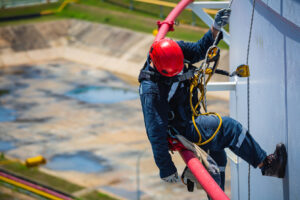The construction industry is a critical sector in the United States, responsible for shaping the nation’s infrastructure and driving economic growth. However, it also has one of the highest rates of business failure of any economic sector. In fact, according to the Washington Post most construction projects are either over-budget or delayed with only 8.5% finished on time and within budget.
Construction projects are complex, with numerous stakeholders, changing requirements, and evolving regulations. Risks abound at every stage, from design to completion, making it essential to identify and manage potential issues proactively. Let’s explore the most significant construction risks facing the industry today,
Types of Construction Project Risks
Construction projects can pose internal and external risks that include:
- Financial risk: Fluctuating material costs, incorrect estimation, payment delays, or financial inexperience of the contractor are just some of the financial risks in a project.
- Environmental risks: These include severe weather conditions, natural disasters such as earthquakes, pollution, and seasonal implications.
- Technical risk: These include incomplete design, inadequate site investigation, unavailability of materials, design errors, orchanges in project scope or requirements.
- Safety risk: According to the Bureau of Labor Statistics, in 2022, the US construction industry had the highest number of fatal work-related accidents.
- Legal risk: Construction is both heavily regulated and a highly litigious industry.
- Economic risk: Recession, inflation and other economic forces can shrink market opportunities, drive up costs, and dry up project funding.
One of the best ways to control risks is to understand the distinct types and take steps to best avoid these risks. Sadly, there is no way to entirely avoid risks since unknown factors will always emerge throughout a project.
Here are the three risk elements that project management should consider:
- Schedule: Will the project be executed within the projected time?
- Cost: Will the project be completed within the budget?
- Performance: Will the project output satisfy the business and technical goals?
When these risks are quantified, the project team can develop effective mitigation strategies or add proper contingencies to the project estimate.
10 Risk Mitigation Strategies
With a comprehensive risk mitigation strategy, you can plan for the unexpected which in turn minimizes extra costs before they happen. Proper risk mitigation will contribute to higher profits, improve safety, protect finances, and build trust in the project.
- Planning and Risk Assessment: Begin with a detailed project plan that identifies potential risks at each stage of the construction process. Conduct a comprehensive risk assessment to understand the likelihood and impact of each risk.
- Clear Contractual Agreements: Ensure that all parties involved, including contractors, subcontractors, suppliers, and stakeholders, have clear contractual agreements outlining their responsibilities, deliverables, timelines, and dispute resolution mechanisms.
- Financial Risk Management: Set aside contingency funds to cover unexpected costs and delays. Implement financial controls to monitor expenses and ensure that the project stays within the budget.
- Quality Control and Assurance: Implement rigorous quality control measures to maintain high construction standards and minimize the risk of defects, rework, and safety hazards.

- Safety Protocols and Compliance: Prioritize safety throughout the project by implementing robust safety protocols, providing adequate training to workers, and ensuring compliance with relevant health and safety regulations.
- Regular Communication and Reporting: Establish open lines of communication among project stakeholders to facilitate timely information sharing, issue resolution, and decision-making. Implement regular reporting mechanisms to track progress, identify potential risks, and address issues promptly.
- Risk Transfer Mechanisms: Utilize insurance policies, performance bonds, and indemnification clauses to transfer specific risks to third parties, such as insurers or subcontractors, where appropriate.
- Contingency Planning: Develop contingency plans for potential disruptions, such as adverse weather conditions, supply chain disruptions, labor shortages, or regulatory changes, to minimize their impact on the project schedule and budget.
- Technology Adoption: Leverage technology such as Building Information Modeling (BIM), project management software, drones, and sensors to improve project visibility, efficiency, and decision-making.
- Legal and Regulatory Compliance: Stay updated on relevant legal and regulatory requirements, including zoning laws, environmental regulations, building codes, and permitting processes, to ensure compliance and avoid costly delays or penalties.
Mitigate Your Construction Project Risks with KBCm Group
KBCm takes a comprehensive approach to risk management and risk reduction by leveraging years of experience and expertise. Thanks to fully integrated construction and service management, we deliver everything you need to remain compliant, reduce risks and drive efficiencies –regardless of the scope or complexity of your project.



